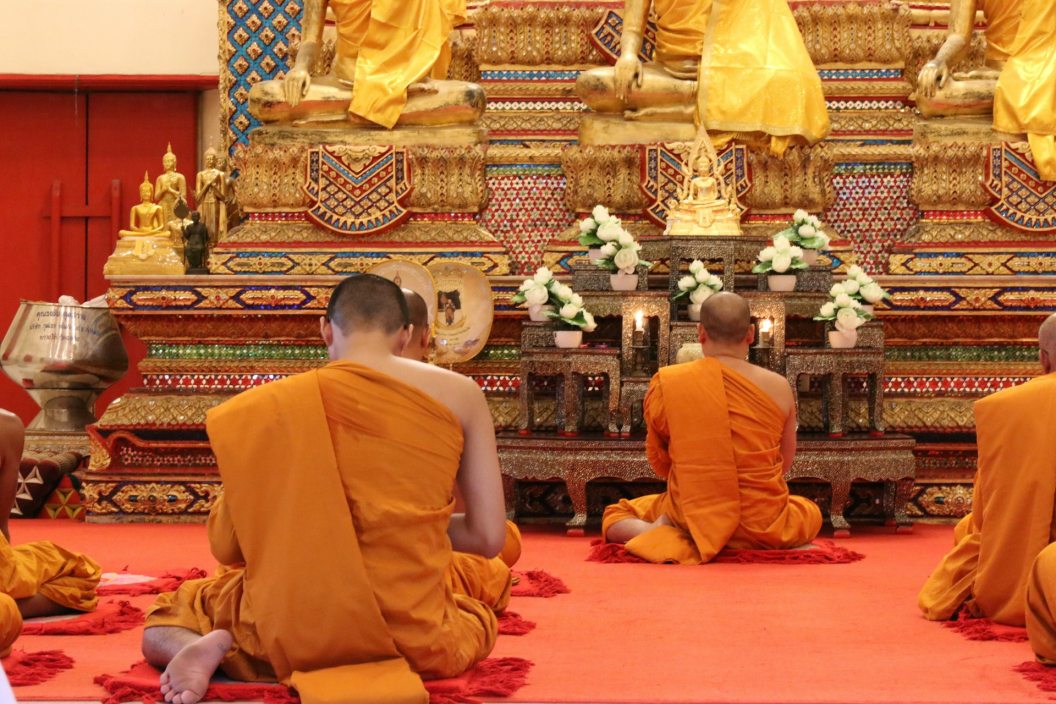In Buddhism, puja (Sanskrit: पूजा, "veneration," "offering," or "devotion") is a ritual practice that serves as a means to cultivate mindfulness, express reverence, generate merit, and deepen one’s connection to the Buddha, Dharma, and Sangha. The practice of puja is found across all the three major traditions of Buddhism (Theravada, Mahayana, and Vajrayana). However, there are some differences about the way puja is conducted across these traditions of Buddhism. For example, Theravada focuses on venerating the Buddha and his teachings by making simple offerings of candles and flower. It emphasizes on making and accumulating merit by chanting mantra, reading texts, giving alms to monks and donating money to monasteries. Whereas, in Mahayana tradition puja is more elaborate and is offered not only to the Buddha but also to the Bodhisattvas (such as Avalokiteshvara and Tara, who help us cultivate virtues like wisdom and compassion) as well. The puja in this tradition includes practitioners making confession of misdeeds and wishing loving-kindness (Bodhichitta) and compassion to all sentient beings. Likewise, puja serves as a key element in Vajrayana tradition as well where Guru, Buddhas and Bodhisattvas are venerated through visualization, mudra, deity yoga, tantric rituals, chanting mantras, creating and offering mandalas and empowerment. All these practices of Vajrayana tradition can be seen during the ganachakrapuja—a feasting ritual in which food is offered to beings from various realms such as bhutaloka, pretaloka, pisachaloka etc. These acts symbolize the non-dual view in which the practitioner, deity, and spiritual realm are enmeshed together and hence inseparable from each other.
Mudra is a Sanskrit word, which means “gesture” and it refers to symbolic hand gestures displayed by images of Buddhas and Bodhisattvas. There are various kinds of mudra and each of them carry different meanings. For example, the gesture of one hand held downwards with the palm open and the fingers pointing downwards is called generosity mudra. This symbolizes welcome, generosity and compassion. The Bodhisattvas Avalokitesvara and Tara are depicted in this gesture. Likewise, wisdom mudra is a pose in which the thumb and finger touch, forming a circle. Similarly, in meditation mudra, the hands rest in the lap, with fingers of one hand resting on the fingers of the other and palms facing upwards. Gautama Buddha and Amitabha Buddha are often shown in this pose.
Different types of puja is conducted in various occasions such as Losar (Tibetan New Year), Monlam, Drupchen, Phowa etc. During Losar, puja offerings are made to protectors like Palden Lhamo. Monlam is a prayer festival with mass recitations for world peace. Drupchen is an intensive group retreats focusing on deity practices. Phowa is a funerary practice that is conducted to transfer the consciousness of the deceased, which is done by reciting the Bardo Thodol (Tibetan Book of the Dead).
Although specific ways of conducting puja varies across the three traditions of Buddhism, the overall aim of all three traditions have similar and overlapping purpose. Puja includes offering incense, flowers, food, and reciting prayers, which helps to cultivate humility and gratitude. Humility and gratitude are two virtues that act as the antidotes against our ego-centric mode of being. Offering (dana) is an essential aspect of Buddhist practice and it develops dana paramita, which is one of the important factors (out of the six paramitas) required to achieve the Buddhahood. Buddhist puja can be conducted in various locations, such as at one’s individual shrine at home, or communally in monasteries with the fellow sangha members or at stupa or at sites of pilgrimage and power spots.
Puja aids in cultivating mindfulness (Vipassana) and Concentration (Samatha), which are two core methods used in the Buddhist meditation practice. Vipassana (insight) meditation is an act of observing the changing nature of all phenomena. In the context of puja, it can be done by observing witling of flowers, flickering butter-lamp, prostrations, mudra, and reflecting on the impermanence of those ritual acts during offerings. Samatha (calm abiding) meditation, likewise, creates a calm and quiet mind. It is achieved by chanting mantras repetitively while conducting puja, which eventually creates a calm and quiet mind.
There are several Buddhist sutras that relate to puja. For instance, Pancharaksha Sutra, Sutra Remembering the Three Jewels, Sutra of Golden Light, Avalokiteshvara Universal Gate Sutra. Pancharaksha Sutra is a set of five protective sutras widely used in Vajrayana Buddhist rituals, especially in Nepal. It is believed to bring blessings and protection. Sutra Remembering the Three Jewels emphasizes devotion to the Buddha, Dharma, and Sangha, often recited during puja ceremonies. Sutra of Golden Light is highly revered Mahayana sutra that is often recited for blessings, purification, and prosperity. Avalokiteshvara Universal Gate Sutra focuses on the compassionate Bodhisattva Avalokiteshvara and is commonly used in puja dedicated to him.
To conclude, Buddhist puja is a versatile practice unifying physical, verbal, and mental devotion to deepen understanding of the Dharma. While forms of puja vary across traditions, the essence remains the same: cultivating mindfulness, merit, and compassion for all beings. Puja is a skillful means to achieve that common essence by deepening faith in the Three Jewels, transforming negative habits into virtues, and moving closer to the ultimate goal—liberation from suffering (nirvana) and attaining Buddhahood.

